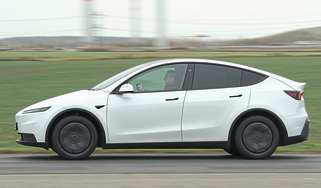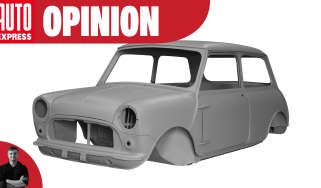Ford EcoSport vs Cactus & Juke
We put crucial new Ford EcoSport crossover through its paces against bold new Citroen and big-selling Nissan
Traditionally, small family cars are all cut from a similar cloth and follow the small hatchback template. But with the spectacular rise in the popularity of SUVs has come a much broader range of styles, shapes and characters to choose from. Which is why the three contenders we’ve gathered here all fit loosely into the supermini SUV category, but go about their business in very different ways.
This is our first chance to drive the Ford EcoSport on UK roads, and since it’s based on Britain’s best-selling car and our Supermini of the Year – the Ford Fiesta – it’s a mouth-watering proposition. If it can carry over even some of the Fiesta’s playful handling, while boosting practicality and visibility, Ford is on to another winner. However, the EcoSport’s route to UK roads has been a unusual one.
It was originally designed in Brazil with emerging markets in mind. We drove a South American versionaround Sao Paulo way back in 2012 and have been waiting patiently ever since. UK cars are builtin India and tweaked for European tastes with higher specification and new powertrains, including a 1.5-litre TDCi diesel and the award-winning 1.0 EcoBoost three-cylinder petrol driven here. But has Ford done enough to disguise the car’s cut-price roots?
Used - available now

2019 Volvo
S60
57,000 milesAutomaticPetrol2.0L
Cash £16,197
2018 Nissan
Qashqai
56,400 milesAutomaticPetrol1.3L
Cash £12,995
2023 Tesla
Model 3
41,074 milesAutomaticElectric
Cash £18,876
2020 Mercedes
GLA
61,248 milesAutomaticPetrol1.6L
Cash £14,197The Citroen C4 Cactus takes a more relaxed approach, majoring on comfort, ease of use and distinctive design. It’s a technique that’s served Citroen well in the past and, with first deliveries next month, looks set to strike a chord with customers tired of makers harping on about sporty handling, when all they want is something to tackle everyday trips with the minimum of stress.
Then again, sporty handling and brash styling have served the hugely successful Nissan Juke well since it invented the class in 2010. The Juke has recently been reinvigorated with a fresh look and a new 1.2 DIG-T turbo engine, but has it still got the game to see off this pair of pretenders?
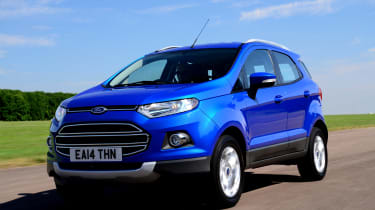
Styling
While its two main rivals have a look all of their own, the EcoSport is more of a Fiesta on stilts, so the proportions are less successful. View it from the front, and Ford’s globally recognised wide-mouthed grille and slim headlights look smart, but from the rear the horrendous spare wheel stuck to the tailgate undoes all the good work with more than a whiffof late eighties Suzuki Vitara.
The interior design will be instantly familiar to Fiesta owners, too, with the same confusing array of buttons strewn across the centre console and a dated LCD screen set deep into the dash. The overall look is angular and modern, but start scratching, poking and squeezing the trim materials and it feels much cheaper than a Fiesta.
Park the Juke next to the EcoSport, and the Nissan looks as if it’s been beamed down from another planet. The mid-life changes are limited to tweaked headlights, a new lower front grille and redesigned rear bumper, but the Juke was so radical four years ago, it still looks fresh now. It’s a similar story inside where the shiny-coloured inserts and motorbike-inspired centre console are hardly subtle, but reflect the sporty way the Juke drives.
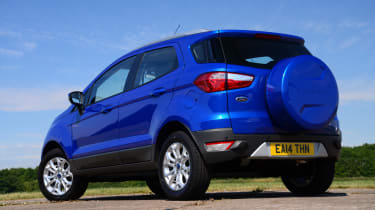
Walking the line between them is the C4 Cactus, which combines quirky flourishes like the Airbump panels and two-piece headlights with minimalist surfaces and perfect proportions. The result could have been a mess, but by being bold Citroen designed something that’s cool and contemporary without being overly aggressive.
And if the outside appeals, then the uncluttered interior should, too, from its flat, wide and squidgy front seats to its stripped-back dash, consisting of a central screen and a digital instrument cluster. You sit lower than in the other cars – the C4 Cactus is based on the C3 platform, but has similar dimensions to a C4, with slightly more ground clearance – and Citroen has made the most of limited resources, placing soft-touch materials on the most prominent surfaces and cheaper stuff lower down.
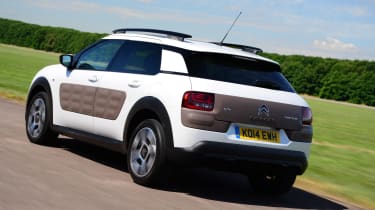
Driving
If the EcoSport should excel in one area, it’s from behind the wheel, and there are clear echoes of the Fiesta. The steering is immediate and direct, while the gearshift has a notchy, mechanical feel.
However, in corners the centre of gravity feels significantly higher as the car tips from side to side. A glance at the spec sheet reveals why – at 1,350kg, this car weighs 259kg more than the Fiesta 1.0 EcoBoost. So while the 123bhp three- cylinder fizzes away under the bonnet of the Fiesta, here it feels laboured and flat. It still maintains its smoothness and refinement at high revs, but getting up to speed is hard work. Once you’re there the ride quality is good, thanks to the extra suspension travel, but in the transition from supermini to SUV the Fiesta’s spark has been lost.
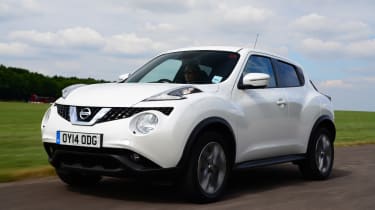
The big surprise is how much faster the C4 Cactus feels than its rivals here. With only 1,020kg to haul around (about 200kg less than an equivalent C4 hatch), it shoots forward once the turbo spools up.
Take things easy, slide the gearstick slowly through its ratios and there’s enough torque for gliding around in higher gears, enjoying the spongy suspension and the peace and quiet in the cabin. If you are in a hurry, though, the Cactus is capable – you’ll just need to be patient, while it leans on its outside springs in corners, before shooting off down the next straight. By contrast, the Juke feels firmer, with meatier steering. Although the ride is never uncomfortable, you feel more bumps than in the other cars – the pay-off is a bit of fun when the road opens up.
With a kerbweight of 1,236kg, the Juke doesn’t have quite the pace of the Cactus off the line, but in-gear acceleration from the new 1.2 DIG-T punches well above its cubic capacity.
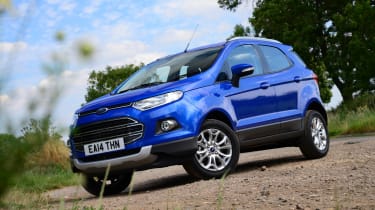
Practicality
In terms of interior space, the EcoSport is hard to argue against. With the split fold rear seats in place there’s a 310-litre boot (the smallest here), but drop them and it offers 1,238 litres (the most here). Rear leg and headroom is top of the pile, too, while the raised driving position is more SUV-like than the Citroen’s.
But spend some time in the Ford and problems begin to emerge, such as thick A-pillars that hamper front visibility and the fact the load area isn’t flat with the seats down. By far the biggest annoyance, though, is the side-hinged tailgate: while it creates a nice low loading lip, it means you’ll need to leave a good five feet of space behind you when you park to open it – not ideal in congested town centres.
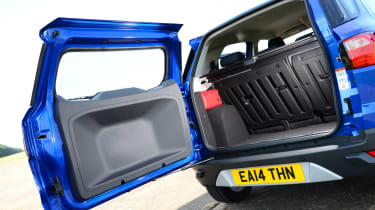
The Juke can’t swallow the same amount of luggage (its 354-litre boot grows to 1,189 litres), but its packaging is better thought through. A false floor lets you decide between a perfectly level loading lip and a flat load area in its higher position, or maximum space for your bags when you lower it. Large adults won’t want to spend prolonged periods in the back, though, as the sloping roofline eats into headroom.
Considering Citroen started with the C3 supermini, the amount of luggage space it’s squeezed out of the Cactus is impressive. With the back seats in place, the 358-litre boot is the biggest here; fold them and it grows to 1,170 litres.
But it’s not all good news. To cut costs and weight, a split-fold rear bench is optional, while the pop-out rear windows might be too claustrophobic for some. Still, we like the fact Citroen has made a virtue of those rear windows by installing huge door bins in the rear, while leg and headroom is on a par with the Juke’s.
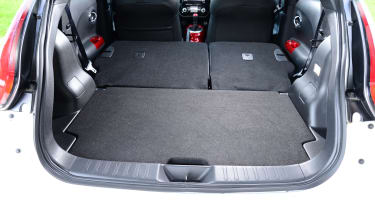
Running costs
If running costs are a priority, all three cars offer a more efficient diesel engine option. But plumping for petrol isn’t the compromise it once was, plus you save on the price (the petrol EcoSport is £500 cheaper). The 1.0 EcoBoost’s 53.3mpg economy and 125g/km emissions aren’t bad on paper (especially as the Juke claims 51.4mpg and 126g/km), but you’ll have to put up with a frustratingly slow 0-62mph time of 12.7 seconds.
Meanwhile, the Cactus perfectly demonstrates the benefit of lightweight engineering. Weighing 216kg less than its closest rival here, it claims 60.1mpg and 107g/km, but is over a second faster from 0-62mph than the Juke.
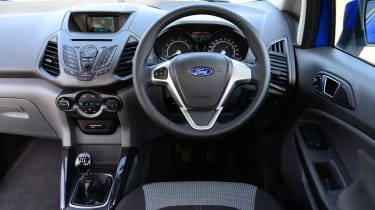
The EcoSport is the cheapest car in this test, and only comes in Titanium spec. But while you get 16-inch alloy wheels, LED running lights and a cooled glovebox as standard, our test model’s Kinetic Blue metallic paint costs extra, as do rear parking sensors.
Our mid-spec Juke costs around £500 more, yet it gets a 5.8-inch screen with sat-nav, plus three driving modes and 17-inch wheels. Our top-spec C4 Cactus Flair is another £500 still, but has all the kit you could need, including sat-nav, a rear parking camera and a seven-inch touchscreen. By comparison the Ford’s kit list – and the whole package, for that matter – feels a generation behind.
So which would we choose?
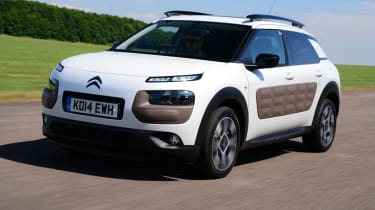
It’s possible to make a case for any one of these cars, depending on where your priorities lie. The EcoSport has the most space inside, the Juke is infused with a sense of fun the other two can’t match and the C4 Cactus is the easiest to live with.
However, look beyond the EcoSport’s practicality and it falls woefully short. Build quality is fine for emerging markets, but not good enough for European tastes, and the Fiesta’s superb handling has been blunted by the extra weight.
If it’s sharp handling you want, the Juke is top of the pile, and the lively 1.2-litre turbo engine gets the best out of the chassis, although the striking body shape compromises interior space. As for the Cactus, it manages to mix desirability, space, efficiency and performance in a package that charms all who drive it – which is why it takes victory.
Or how about the Mokka?
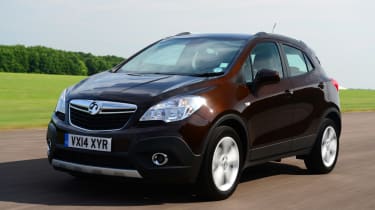
The Vauxhall Mokka fits neatly into this company on the face of it, although we decided to leave it out of our test for a number of reasons.
It’s actually a little larger than our trio, at 4,278mm long, plus it offers maximum boot space of 1,372 litres – so it sits somewhere between the Nissan Juke and its Qashqai big brother. The Mokka is more pricey, too, with even the entry-level 113bhp 1.6 Exclusiv petrol costing £18,264.
However, there are some cracking offers out there that help to make the Mokka almost as affordable as the EcoSport, C4 Cactus and Juke.

